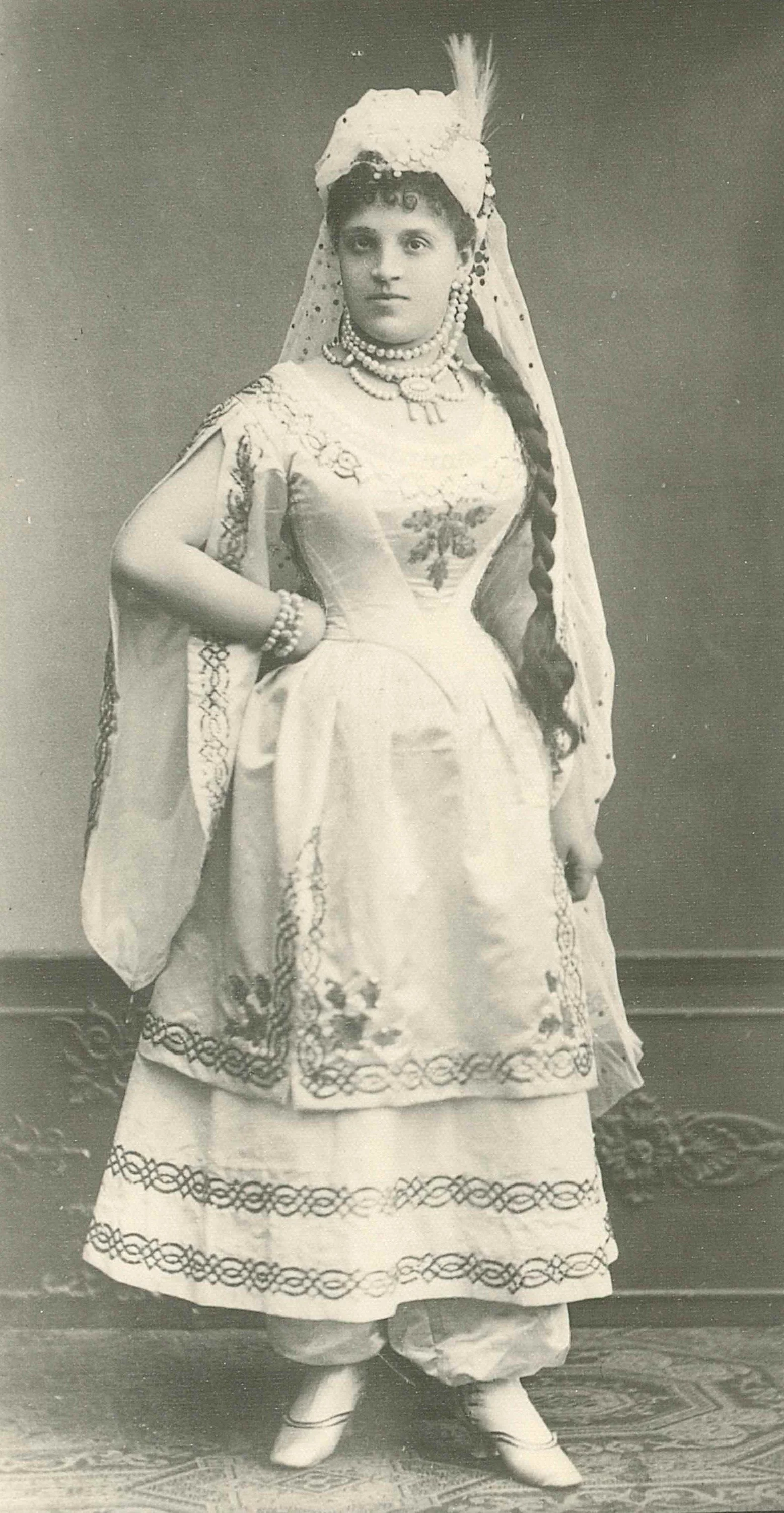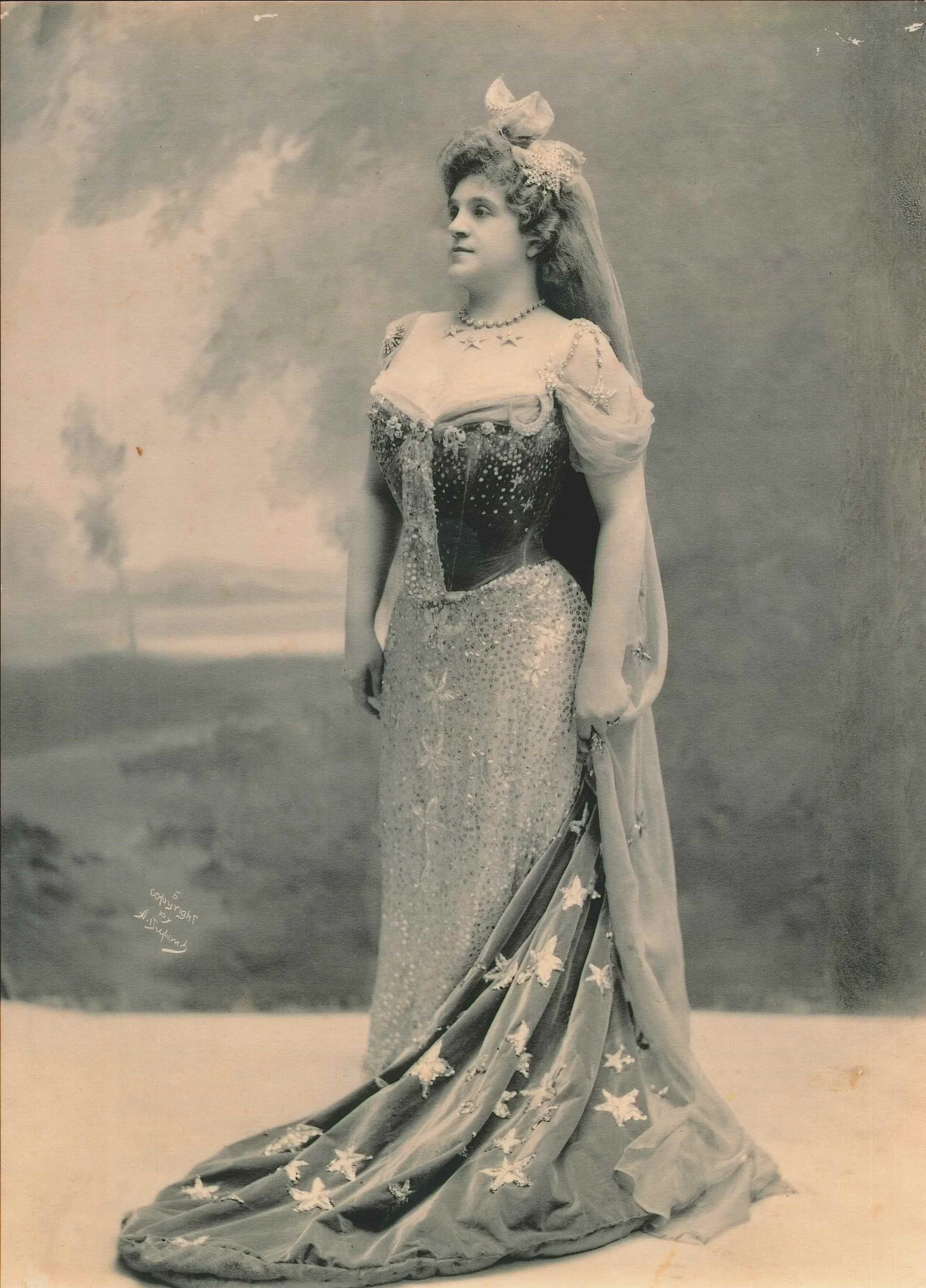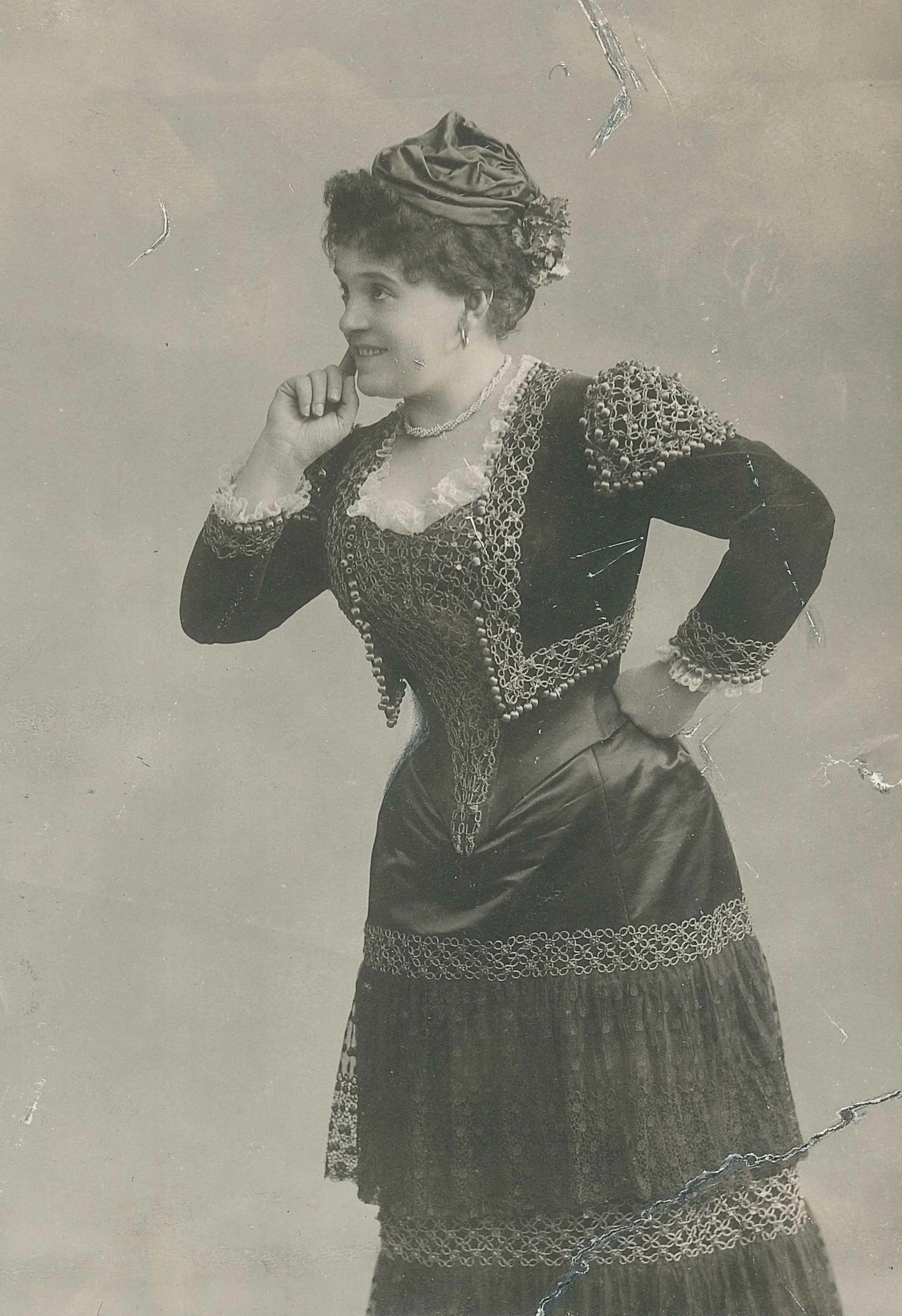MASTERING MOZART
On View May 25 - October 14
Marcella Sembrich (1858-1935) was considered one of the finest interpreters of Mozart at the turn of the 20th century. Her polished legato and mastery of the bel canto style of singing, combined with her endearing stage presence, earned her praise as “the greatest florid dramatic artist of the lighter class of modern times.” Knowing this, it is no surprise to learn that nearly one fifth of her 466 performances at New York’s Metropolitan Opera were in Mozart operas. Visitors to The Sembrich can explore each of the four Mozart operas and the roles in which Sembrich excelled. Below is an overview of the four roles described in the exhibition and the objects and artifacts relating to each. The text is a truncated version the original exhibition interpretation.
Sembrich as Konstanze in Mozart’s
Die Entführung aus dem Serail. (1880)
Sembrich as Queen of the Night in Mozart’s Die Zauberflöte . (1900)
Sembrich as Susanna in Mozart’s
Le nozze di Figaro. (ca.1900)
Sembrich as Zerlina in Mozart’s
Don Giovanni. (ca.1900)
Die Zauberflöte (The Magic Flute)
Arguably one of Sembrich’s most iconic portrayals at the Metropolitan Opera was of The Queen of the Night in The Magic Flute. This is the first of Mozart’s coveted soprano roles that Sembrich sang when she joined the Saxon Royal Opera (Dresden, Germany) in 1878. Sembrich was seen as the Queen of the Night across Europe, but it is her performance in the Met’s 1900 revival that remains one of her most well-remembered portrayals.
By the end of the 19th century, The Magic Flute had not been produced in New York for some time. Seizing the opportunity to create a new operatic spectacle, The Metropolitan Opera announced that a revival of Mozart’s beloved opera would be produced and open on Friday, March 30, 1900, with Marcella Sembrich as the infamous Queen of the Night. The new production was one of the most highly anticipated musical events in New York, modeled on a Munich production which had been the spectacle of the European opera scene the year before.
Henry Krehbiel, one of New York’s most influential critics, declared, “The Magic Flute has come to stay as long as time will allow.” Marcella Sembrich reigned as the Met’s Queen of the Night for 22 more performances between 1900 and 1904.
Today, all that remains of this monumental production is Marcella Sembrich’s iconic spangled costume for The Queen of the Night. Robert Tuggle, the former director of the Met Opera Archives hailed this gown and the other costumes in our collection as “perhaps the finest surviving example of the grandeur of opera in the late-19th and early-20th centuries.”
This gown was recently conserved by nationally recognized textiles conservator Gwen Spicer. This extensive conservation project was supported by The Coby Foundation, NYSCA/Greater Hudson Heritage Network, the Sandy Hill Foundation, and other generous individuals.
Artifacts on display relating to The Magic Flute include:
Marcella Sembrich’s “Queen of the Night” Costume (pictured)
Designed by Betha Pechstein (ca. 1899).Miniature Portrait of Marcella Sembrich as Queen of the Night.
Watercolor and Gouache on Ivory by I.C. MacKeown (ca. 1937).Vocal Score for “Il Flauto Magico” with Sembrich’s Annotations.
Die Entführung aus dem Serail (The Abduction from the Seraglio)
Sembrich first enraptured audiences in the role of Konstanze while under contract as a member of the Saxon Royal Opera (Dresden, Germany). Sembrich sang with the Royal Saxon opera for two seasons beginning in 1878. While widely remembered for her debut in Donizetti’s Lucia di Lammermoor, reviews from local critics coveted most her portrayal of Konstanze in Die Entführung, which she first performed on March 9, 1880. Konstanze was also the final role in which the Dresden public would hear Sembrich.
Having decided to seek greater opportunities, two months later Sembrich sailed to London, seeking an audition with Ernest Gye, the manager of Covent Garden’s Royal Italian Opera. Undoubtedly knowing of Sembrich’s success in Die Entführung in Dresden, Gye launched a revival of the work in June of 1881 specifically for Sembrich. Her performance as Konstanze proved to be even more exquisite than anticipated and, of the five roles that she had performed in London, this was the most highly praised:
“The artist […] was Madame Sembrich, on account of whose rare powers, it may be, that the opera again saw the light… The Polish lady’s execution of all the music showed that she knew it perfectly, and suggested that she loved it well, but her delivery of the great song was an achievement to be remembered. For fluent vocalization, brilliant style, and sustained strength this effort deserved to rank among the best in operatic annals.
(The Daily Telegraph: London. June 11, 1881.)
The role remained in Sembrich’s repertoire, though it was performed less frequently in the subsequent years. Interestingly, despite her popularity in the role, Sembrich never performed in this opera in the United States. Indeed, The Metropolitan did not produce the work until 1944, nearly three decades after Sembrich’s retirement.
Artifacts on display relating to Die Entführung include:
Hand Colored Etching of Salzburg, Mozart’s Birthplace.
Watercolor & Ink on Paper. Artist Unknown (ca. 1885).
From the personal art collection of Marcella Sembrich.Etching of Young Mozart.
Ink on Paper by Hans Meyer (1846).Vocal Score for “Il Seraglio” with Sembrich’s Annotations.
Le nozze di Figaro (The Marriage of Figaro)
The role of Susanna was one of Sembrich’s most celebrated portrayals throughout her career, and indeed was one of her own favorites. Her polished singing and charming stage presence in her performances of Mozart’s clever bride-to-be (in both Italian and German) took audiences in London, Warsaw, Munich, and Berlin by storm between 1884 and 1896.
After an absence of 15 years, Sembrich returned to the Metropolitan Opera in 1898, appearing as Susanna for the first time in the United States. The revival productions of the opera also starred other major opera stars in leading roles including baritone Giuseppe Campanari as Figaro, soprano Emma Eames as the Countess, and Polish tenor Edouard de Reszke as the Count. Her American debut as Susanna was an enormous success, with Sembrich and Eames repeating the opera’s famous letter duet. The noted critic W.J. Henderson wrote in New York Tmes:
“Mme. Sembrich's Susanna was the performance of a very great artist, who loves and reverences her Mozart and sings his music with an understanding all too rare in these days. Her conception of the part was perfect and she acted throughout with the most admirable skill. How many Italian opera singers would refuse to repeat the letter duet with the same letter. This Susanna, when she found the audience demanding an encore, showed the Countess that there was a big blot on the letter and induced her to tear it up. Then she sat down and wrote the letter from dictation a second time.”
Sembrich performed the role of Susanna 32 times between her reintroduction to the United States in 1898 and her retirement from opera in 1909, making it her most popular Mozartian role during her Metropolitan Opera career. During her final season with the Met Opera, the famous musician Gustav Mahler, considered one of the era’s foremost masters of Mozartian music, conducted all of Sembrich’s performances in Le nozze, as well as the Act III March which preceded the closing ceremonies at her Grand Farewell Concert on February 6, 1909.
Artifacts on display relating to Le Nozze di Figaro include:
Sterling Silver Vase (1909). Inscribed with “Susanna Feb, 5, 1909”
Silk Velvet Bolero Jacket worn by Marcella Sembrich for Le Nozze.
Designed by Bertha Pechstein, Berlin. (ca. 1888)Photograph of Emma Eames (ca. 1900)
Recording of Sembrich and Eames Performing the “Letter Duet” from Le Nozze
Victor Talking Machine Company. (1908)Recording of Sembrich Performing “Deh vieni, non tardar” from Le Nozze
Victor Talking Machine Company. (1906)
Don Giovanni
The Opera & The Role
Don Giovanni is regarded by scholars and critics as one of the greatest operas ever composed. One of Sembrich’s first documented portrayals of Zerlina was at the Metropolitan Opera during the 1883-84 inaugural season. Sembrich was the first to portray the Spanish peasant woman at the Met, singing the role twenty-one times during her tenure with the company. In addition to being considered one of the greatest operas, Don Giovanni also has a reputation for being one of the most difficult works in the Italian opera genre. Of Sembrich’s twenty-one performances with the Met, six were during the inaugural season, and the rest during her tenure from 1898-1909. Later reviews show that following her fifteen year hiatus from the US, she had returned as an even more polished interpreter of Mozart:
“The enthusiasm was that of people who had paid well to hear famous singers and heard them. Mme. Lehmann was called out four or five times after her grand aria. Mme. Nordica was acclaimed after Elvira's principal aria and Mme. Sembrich was wildly applauded at every opportunity… Mme. Sembrich's Zerlina was the sparkling, brilliant piece of comedy that might have been expected of this splendid mistress of vocal art and acting. Her voice was in good condition, her acting was all that could be desired and she put herself completely into the picture at all times. She was most enthusiastically applauded for her lovely delivery of ‘Batti, batti.’”
(The New York Times: New York, January 1899.)
“Mme. Sembrich was the Zerlina, one of the most perfect and wholly charming embodiments of this part that it is the fortune of the present generation of operagoers to enjoy, and given last evening with delightful beauty of voice and style and the fullness of grace and humor that irradiates all her assumption of comic parts.”
(The New York Times: New York, January 1908.)
Artifacts on display relating to Don Giovanni include:
Selk Velvet Bolero Jacket worn by Sembrich for Don Giovanni
Designed by Bertha Pechstein, Berlin. (ca. 1888)Recording of Sembrich Performing “Batti, Batti” from Don Giovanni.
Victor Talking Machine Company. (1908)Assorted Sembrich recital programs including arias from Don Giovanni.





